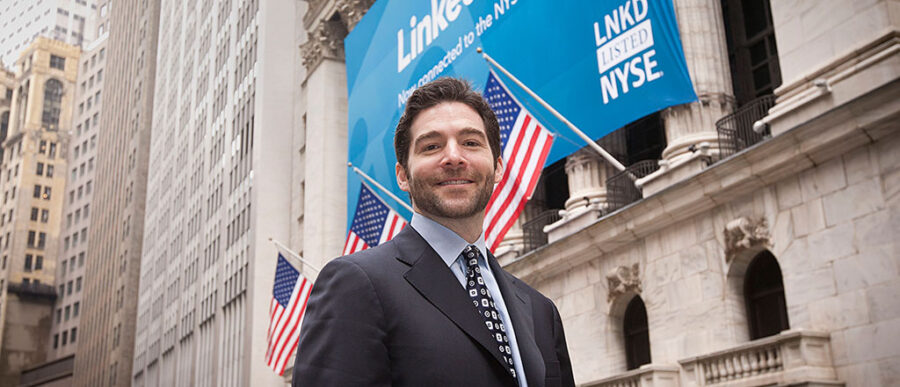The last few years have seen the emergence of a number of successful public technology companies. The social networking site LinkedIn would likely be at the top of many of those rankings.
LinkedIn was founded by a team headed by Reid Hoffman in 2002 and went public in 2011. While many of LinkedIn’s peers ultimately disappointed their backers once they debuted on the open market, the site has been enthusiastically received by investors. It has also become a go-to spot for networking and job searching.
Jeff Weiner joined LinkedIn as CEO in 2008 after a stint at Warner Brothers as head of its online divisions, developing the company’s initial business plan in that space. Previously he spent more than seven years at Yahoo, including a position as executive vice president of its network division. At Yahoo, he was head of the team that directed the acquisition of Inktomi, AltaVista and FAST, in addition to helping to develop the company’s search technology.
During a fireside chat at Wharton’s San Francisco campus held in conjunction with the Wharton Entrepreneurship Alumni Dinner, Weiner spoke with Andrew Trader, co-founder of the social games site Zynga, about LinkedIn’s evolution, the importance of good execution and Weiner’s approach to recruiting.
A Rocket in Space
According to Weiner, being part of a hyper-growth company is “like being a rocket in space.” Just a slight initial miscalculation in strategy can become a serious problem further down the road. “Hyper-growth companies often get so caught up with innovation and the adrenaline rush that they chase the next bright shiny thing at the expense of getting their launch trajectory right,” he noted.
“It’s invaluable to have someone on the team who understands technology and the way it’s going to be changing society. Then the job is to get in front of those trends and unlock a tremendous amount of value.”
Being able to execute well quarter after quarter involves putting the necessary processes in place early on, which is typically a lot less glamorous than pursuing the next technology breakthrough, Weiner said. “In addition, you need to be constantly revisiting this stuff, because the infrastructure you put into place five or 10 years ago, in a world dynamic such as ours, is something you’re going to have to reinvest in.”
When LinkedIn launched in 2003, the site received as few as 20 sign-ups on some days. Today, the site reports having more than 259 million users in 200 countries and more than two new sign-ups per second. In its most recent quarterly earnings report, LinkedIn reported revenue of $393 million — a 56% increase from the same period in 2012 — but the company’s high valuation has led to questions over whether it can continue to grow at such a dramatic rate.
As the site begins its second decade, Weiner said that he is always looking for potential new hires with what he called “technology vision.” In a world increasingly driven by technology, “it’s invaluable to have someone on the team who understands technology and the way it’s going to be changing society. Then the job is to get in front of those trends and unlock a tremendous amount of value.”
Weiner said his interviews with job candidates always begin with the same two initial questions: “What is your dream job?” and “What is it that you want to accomplish?” He noted that as the firm has grown, culture and values have become increasingly important. “A few years ago, I might have rolled my eyes and thought of some Dilbert comic strip. I wasn’t a big fan,” he stated. “The companies I had been at had codified cultures and values, but people weren’t walking the walk.”
It wasn’t until he got to LinkedIn, however, that Weiner realized that such things need to go beyond mere platitudes that show up in annual reports or on posters decorating employee break rooms. “We set about establishing very clearly what our values were,” he said. “And far more important than that, we live them. We live them every day in every way possible, and that starts with leadership.”
The Next Play
As he contemplates LinkedIn’s future, Weiner is reminded of the philosophy of Duke men’s basketball coach Mike Krzyzewski. “Every time the Duke Blue Devils complete a sequence, on either the offense or defensive side of the court, no matter how well or poorly they performed, the coach yells out the same thing: ‘Next Play,’” Weiner noted. “He doesn’t want the team celebrating if they did something extraordinary, but he also doesn’t want them lamenting a poorly executed play.”
“After we filed, I walked around and thanked every employee that I could get to. What struck me was that everyone I went up to talked about our next play.”
When LinkedIn filed for its initial public offering in January 2011, Weiner said it was important that employees understood that going public was just one more stepping stone, as opposed to the company’s end game. “After we filed, I walked around and thanked every employee that I could get to. What struck me was that everyone I went up to talked about our next play. It was ‘Next play this,’ and ‘Next play that.’” The phrase became LinkedIn’s unofficial mantra; when employees rang the opening bell at the New York Stock Exchange on the company’s first trading day, they had T-shirts printed with the “LNKD” ticker symbol on one side and “Next Play” on the other.
“I draw a very clear distinction between leadership and management,” Weiner noted. “When I was younger, I didn’t understand the difference. For me, leadership is the ability to inspire others to achieve shared objectives.” The key term there is “inspired,” he added: “For me, that’s the entire difference between leaders and managers. Managers tell people what to do. Leaders inspire them to do it.”
According to Weiner, when employees come to a manager with a serious issue, the manager must be able to understand where the employees are coming from, including their strengths and weaknesses, fears, what motivates them and what inspires them. “That takes an inordinate amount of time and energy,” he noted. “But most managers want to get it over with as quickly as possible so they can move onto the next thing.”
Instead, Weiner said managers need to be able to put themselves in the shoes of the people they work with and understand things from others’ perspectives. “As human beings, most of us tend to project our own worldview onto other people,” he pointed out. “This is especially common in less experienced executives, and I was once one of them.”
Now that LinkedIn is a publicly traded company, Weiner also has to consider the expectations and motivations of the company’s shareholders. “You want to find investors who will think not just about today, but next year; the next three years; the next five years,” he noted. “Because if you’re trying to build out a truly game-changing transformational platform, it costs. Those investors are out there, and if you can attract them, they will stick with you.”
It’s up to company leadership to make sure the firm as a whole doesn’t fall prey to the quarter to quarter expectations of analysts and Wall Street at large, Weiner added. When people ask him for advice about going public, Weiner noted that his first suggestion is, “Don’t go until you’re ready.” By readiness, he means “knowing what it is you are trying to accomplish, having a sustainable competitive advantage, having the right team in place — and then not wavering from that.”
“During the day, I carve out a couple of hours, without fail, when nothing is scheduled. It’s buffer time; a time to think strategically and to just catch my breath.”
‘Happy Wife, Happy Life’
Prioritization is equally important when balancing a high-stress leadership position with personal and family life, Weiner said. “It took me four years to realize what made me happy: looking forward to going to work in the morning, and looking forward to coming home at night,” he noted.
Weiner credited his wife with being the foundation of their home. “When I get asked about the most important piece of advice I was ever given, I repeat what an old friend told me years ago: ‘Happy wife, happy life.’ Because she is such an incredible wife and mother, it affords me the opportunity to do what I do.” But Weiner added that he has had to prioritize in order to be home in time to tuck his daughters in at night, and to make sure business trips don’t keep him away for too long.
What has helped him do that, Weiner said, is adhering to a strict regimen for things like when he wakes up in the morning and when he exercises. “And, during the day, I carve out a couple of hours, without fail, when nothing is scheduled,” he noted. “It’s buffer time — a time to think strategically and to just catch my breath.”
He advised attendees that a similar tactic can be invaluable for accomplishing their career goals. “The single most important thing that people can do in terms of realizing their dreams professionally is to understand exactly what it is they want to accomplish,” Weiner said. “It sounds simplistic, but it never ceases to amaze me how many people are well down the path of their career, but who never took the time to figure out what it is they actually want to do. And then they wonder why they’re not happy, motivated or inspired by work.”



